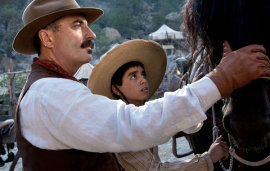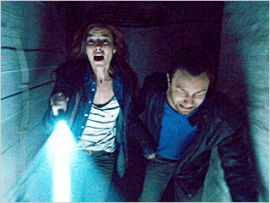 FOR GREATER GLORY
FOR GREATER GLORY
To my considerable chagrin, before seeing For Greater Glory, I had no knowledge of the Cristero War that serves as the film's subject - a brutal conflict between devout Roman Catholics and the Mexican government that, in the late 1920s, claimed nearly 100,000 lives. Consequently, I thank director Dean Wright and screenwriter Michael Love for their two-and-a-half hour exploration of this years-long struggle, a movie that's intensely informative and sincere, and mostly engaging. If only it weren't also so sentimental, and so manipulative.
You kind of expect blandly rote speechifying and good-versus-evil simplicity in this sort of determinedly old-fashioned historical epic, and Wright's movie certainly delivers; scene after scene finds noble characters asking rhetorical questions such as "Who are you if you don't stand up for what you believe?!" while composer James Horner's trumpets and violins wail on the soundtrack. Yet the movie is positively shameless about wrenching tears, especially when the pre-teen martyr-to-be José - played by the startlingly confident Mauricio Kuri - enacts his own passion play, trudging with ravaged, bloody feet to the site of his symbolic crucifixion. Between José's narrative and Peter O'Toole's doomed cleric and the copious tears that fall from our heroes in a never-ending stream, For Greater Glory is too intentionally calculating for its own good, and you kind of long for more poetic imagery; the film has the blandly serviceable look and feel of an above-average TV-movie on a subpremium cable channel. Still, the forcefulness of the story keeps it all moderately compelling, and matters are greatly aided by cast members Oscar Isaac, Catalina Sandino Moreno, Santiago Cabrera, Nestor Carbonell, and star Andy Garcia, whose subtle, anguished turn as military leader Enrique Gorostieta Velarde allows us the rare chance to see the actor in an expansive role wholly deserving of him. It's been 25 years since Garcia played his endearing, crack-shot lawman in The Untouchables, and the man still seems almost incapable of missing the mark.
 CHERNOBYL DIARIES
CHERNOBYL DIARIES
As many of us know and frequently lament, most modern horror movies are saddled with terrible endings, but is any other movie genre more dependent on strong endings? If a comedy gives you enough laughs before an unsatisfying climax, or a drama fills you with enough emotion, you can more easily shrug off disappointing resolutions. But when a horror film delivers enticing, suggestive, frightening build-up only to leave you rolling your eyes and sighing, "Oh, come on," you're oftentimes more than disappointed; you're angry, and somewhat resentful toward the filmmakers for wasting your time.
Case in point number 3,785: Chernobyl Diaries, director Bradley Parker's scare flick in which a sextet of "extreme tourists" explore a seemingly abandoned town near the Ukrainian disaster site, and wind up terrorized by mobs of bald, growling, flesh-eating mutants. (You expected something else?) For nearly half its length, the movie - despite the generally irritating, seemingly improvised banter - is effective and creepy, and boasts some great shocks; I think I was just a tad more surprised than the film's characters when they walked through an apartment building's second floor and a freakin' bear charged at them. But once the radioactive source of the terrors becomes apparent, Parker's outing becomes every retrograde, predictable horror trifle you've ever seen, complete with characters acting with numbing stupidity, "Gotcha!" effects that land right on cue, precious little imagination in the staging, and, yes, a silly final shot before the end credits that inspires a few viewers to legitimately boo. Despite the rather remarkable scenic design and a few of the performers - especially, and unexpectedly, 25-year-old pop star Jesse McCartney - displaying a friendly naturalism, Chernobyl Diaries turns out be a nuclear waste.
 TORNADO ALLEY 3D
TORNADO ALLEY 3D
For anyone who ever had a yen to catch the Discovery Channel's recently canceled Storm Chasers on the big screen - a big, big, big screen - I heartily recommend the Putnam Museum's current booking of Tornado Alley 3D, director/co-writer Sean C. Casey's 40-minute survey of extreme-weather activity and the brave souls (Casey among them) compelled to study it up close and personally. Kids will likely find it all fascinating, even though for my tastes, there was a bit too much time spent on the mechanics of our guides' über-sturdy, storm-chasing vehicle, and the ending, I thought, was a little anticlimactic. (There's also a somewhat eyebrow-raising confusion regarding the timeline to the movie, which obviously includes footage taken over several years; a car is seen sporting a 2011 license-plate sticker, yet gasoline, as we see, is $2.35 a gallon.) Still, there are remarkable images galore: a herd of cattle facing the winds, and subsequently forced, in tandem, to walk backward; a twister that forms and then gently touches the ground before evaporating; a jerky, horizontal tracking shot that shows the extreme difficulty in catching storms on the fly. And the first five minutes of Tornado Alley 3D, with the flat landscapes taking up only about 5 percent of a screen mostly devoted to sky, are absolutely breathtaking. I truly enjoyed the latest edu-tainment offering at the Putnam, and its bleakly serene, moody, disquieting opener immediately put me in mind of another film I'm now dying to see at the venue, though I don't know how much success I'll have in suggesting a six-story rendering of Capote.










